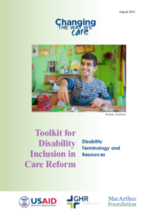The terminology and tips that follow may help as you use the Toolkit for Disability Inclusion in Care Reform Toolkit and apply its principles to your program activities. It is recommended that you become familiar with these terms before reading the rest of the content and revisit as needed. Please keep in mind that disability is an evolving concept. Language that is preferred in one context may be different in another. Ask local organizations of persons with disabilities (OPDs) for the preferred terms in your language and country text.
Always use person-first terminology. For example, use “person with a disability” rather than “disabled person,” and “child who is blind” or “child with a vision impairment” rather than “blind child.”
Avoid terms that have negative connotations, such as “suffer,” “suffering,” “victim” or “handicapped.” Speak of a “wheelchair user” rather than a person who is “wheelchair-bound” or “confined to a wheelchair.”
Use “persons without disabilities” or “persons without impairments” rather than “normal or regular persons.”
Do not use acronyms to refer to children with disabilities; use “persons with disabilities” instead of “CWD” or “PWD.”

